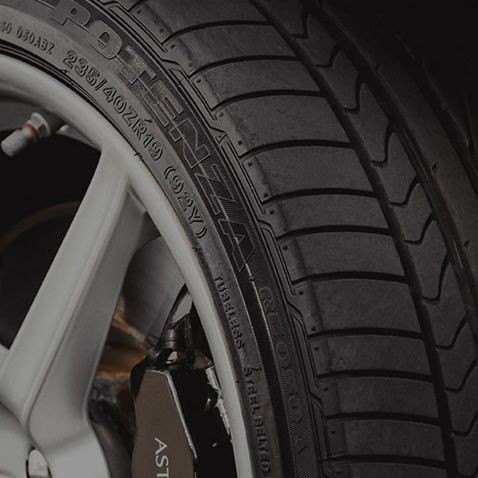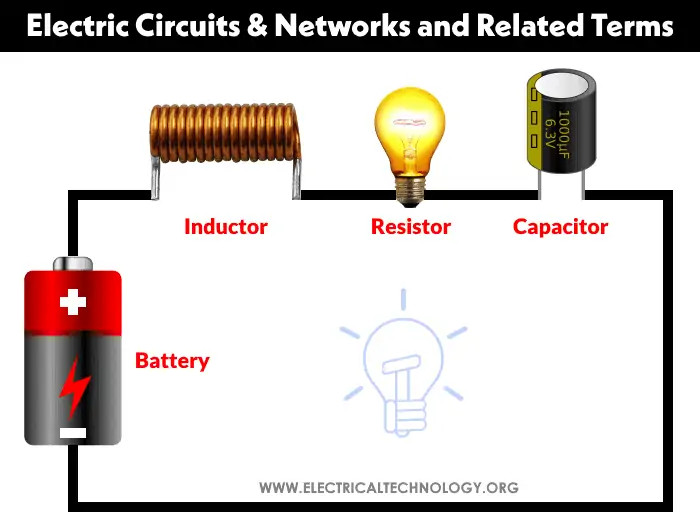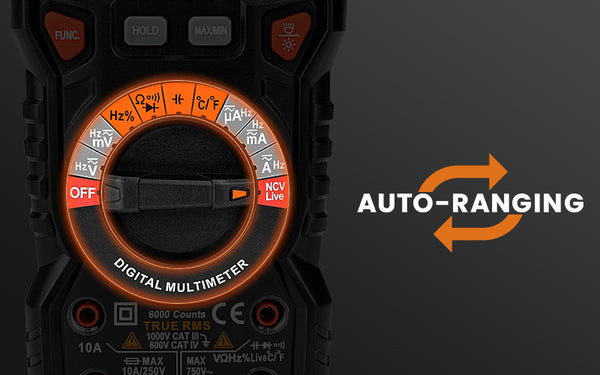What Are the Common Types of Sensors Found in Cars and What Are Their Functions?

Navigating car troubles? Electrical devices called car sensors monitor your vehicle’s condition and alert you. These automotive sensors often adjust the engine to suit the situation. CARDIAGTECH.NET is here to guide you through understanding these vital components, ensuring your vehicle runs smoothly and efficiently, improving fuel efficiency, and enhancing safety on the road with advanced warning systems. Dive in to learn about sensor types, troubleshooting, and how to keep your car in top shape!
1. What Purposes Do Car Sensors Serve in Modern Vehicles?
Car sensors primarily serve to “sense” and “monitor” critical vehicle parameters. The primary function is to gather data and transmit it to the Electronic Control System (ECS). According to a study by the University of Michigan Transportation Research Institute in March 2023, modern vehicles have an average of 70-100 sensors, each collecting and relaying data to optimize performance and safety. The ECS then uses algorithms to assist in making specific adjustments, translating physical and chemical changes into electric signals to inform the driver.
These sensors help manage various aspects of the car, from engine performance to safety features. For example, they monitor the engine’s oxygen or fuel intake and predict potential mechanical issues, thereby enhancing safety and efficiency. By providing real-time data, these sensors allow for immediate adjustments, ensuring optimal performance and preventing potential damage.
2. How Do Car Sensors Work in Modern Vehicles?
Car sensors work by detecting changes in various parameters, such as pressure, temperature, and flow, and converting these changes into electrical signals. To understand this, think of the human body. Our five senses help us stay aware of our environment. Similarly, car sensors act as sensory organs, notifying the CPU when issues arise. The processor then provides information to the driver through dashboard lights, screen alerts, or auditory warnings.
Consider the fuel level sensor: it tells you how much fuel is left and alerts you when refueling is needed. Modern cars may also integrate GPS with the fuel level sensor, enhancing your driving experience. This real-time data collection and response system is crucial for maintaining the vehicle’s health and ensuring a safe driving experience.
3. What Are the Different Car Sensor Types in Automobiles?
Modern cars incorporate an increasing number of sensors to enhance detection capabilities, ensuring safe and comfortable journeys. While not every car has all types, 12 essential car sensors are commonly found in most vehicles. Here’s a detailed look:
3.1. Oxygen (O2) Sensors
The ideal air-to-fuel ratio for an internal combustion engine is 14.7:1. Oxygen sensors, or O2 sensors, monitor the oxygen content in the vehicle’s exhaust system. According to the EPA, properly functioning oxygen sensors can improve fuel efficiency by up to 40%. The VCU uses this data to adjust the air/fuel mixture for optimal engine performance.
 Oxygen sensor functioning in vehicle exhaust system
Oxygen sensor functioning in vehicle exhaust system
If the O2 sensor fails, it can lead to poor fuel economy, increased emissions, and potential damage to the catalytic converter. Regular inspection and replacement of O2 sensors can maintain optimal engine performance and reduce environmental impact. CARDIAGTECH.NET offers high-quality O2 sensors that ensure your engine runs efficiently and cleanly. Contact us on Whatsapp at +1 (641) 206-8880 for expert advice and immediate assistance.
3.2. Mass Air Flow (MAF) Sensor
The mass airflow sensor measures the volume of air entering the intake system. The VCU uses this information to determine the optimal amount of fuel to inject for combustion. The MAF sensor is typically located between the intake filter and the intake manifold. Research from the Society of Automotive Engineers (SAE) in 2022 indicated that faulty MAF sensors could decrease engine efficiency by 10-15%.
If the MAF sensor fails, the VCU won’t know how much fuel to inject, resulting in subpar engine performance. Symptoms of a failing MAF sensor include rough idling, stalling, and a decrease in fuel efficiency. Replacing a faulty MAF sensor is crucial for maintaining engine performance and fuel economy.
3.3. Engine Oil Level Sensor
Maintaining the recommended engine oil level is essential to prevent catastrophic engine damage. Low oil levels can cause significant wear and tear on the internal combustion engine (ICE). According to a study by the American Automobile Association (AAA) in 2023, low engine oil levels are a leading cause of engine failure.
This sensor, often found on the side of the oil pan, triggers the engine oil warning light on the dashboard. If this light comes on, check the oil levels immediately. Regular oil checks and timely refills can prevent severe engine damage and extend the life of your vehicle. CARDIAGTECH.NET provides tools and equipment to help you easily monitor and maintain your engine oil level. For consultation, contact us at 276 Reock St, City of Orange, NJ 07050, United States.
3.4. Engine Oil Pressure Sensor
All internal combustion engines (ICEs) use forced lubrication systems to ensure engine oil reaches all engine parts, enabling flawless functioning and prolonging engine life by preventing metal-on-metal contact. A report by the National Institute for Automotive Service Excellence (ASE) in 2024 highlights that maintaining proper oil pressure is critical for preventing engine wear.
The engine oil pressure sensor, normally located at the base of the cylinder head, connects to the engine oil warning light on the dashboard. In some cars, it may also be linked to the check engine warning light. Ensuring proper oil pressure is crucial for the longevity and performance of your engine.
3.5. Coolant Temperature Sensor
Heat is the enemy of efficiency. Every modern engine has a robust cooling system to maintain optimal operating temperature. According to the U.S. Department of Energy, maintaining the correct engine temperature can improve fuel efficiency by up to 3%. These systems circulate coolants to take heat out of the engine, recooling the coolant via the radiator.
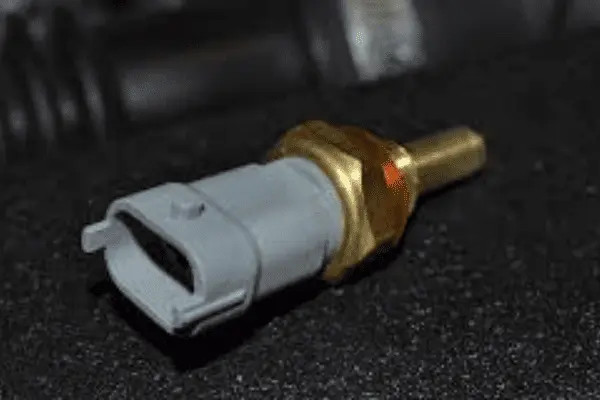 Coolant Temperature Sensor in a modern vehicle's engine
Coolant Temperature Sensor in a modern vehicle's engine
If the coolant temperature goes too high, the sensor sends a signal to the VCU, which illuminates the coolant temperature warning light on the dashboard. Stop immediately to prevent overheating and potential engine seizure. Regular coolant checks and system maintenance are essential for preventing engine damage.
3.6. Coolant Level Sensor
Coolants are pushed through the engine to prevent overheating. When the coolant level drops below a preset threshold, the coolant level sensor, located inside the expansion tank or at the bottom of the radiator, triggers a warning light. Research by the Cooling Systems Institute in 2022 showed that low coolant levels could increase engine wear by up to 50%.
Use only coolants approved by the manufacturer for optimal cooling and to lower the risk of an overheated engine. Maintaining proper coolant levels is crucial for preventing engine damage.
3.7. Air Intake Temperature Sensor
The temperature of the air entering the engine can affect the car’s performance. Colder air is denser, containing more oxygen molecules. The air intake temperature sensor is located between the intake filter and the intake manifold, similar to the MAF sensor. A study published in the “International Journal of Engine Research” in 2023 indicated that optimizing air intake temperature can improve engine efficiency by 5-7%.
When the air intake temperature sensor and MAF sensor are combined, the VCU can calculate the ideal fuel injection volume to keep the engine running efficiently. Monitoring and adjusting air intake temperature is essential for optimizing engine performance.
3.8. Manifold Absolute Pressure (MAP) Sensor
The MAP sensor’s primary job is to communicate critical pressure data to the engine manifold. It calculates the pressure difference inside and outside the engine manifold to ensure the engine always gets adequate fuel, regardless of external pressure differences. According to a report by Bosch in 2022, accurate MAP sensor readings are crucial for maintaining optimal engine performance.
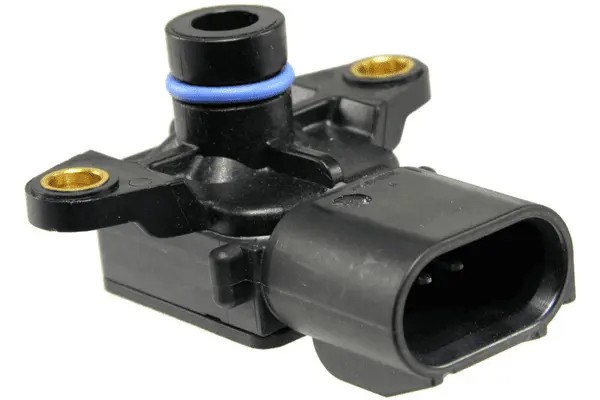 Manifold Absolute Pressure (MAP) Sensor in an engine
Manifold Absolute Pressure (MAP) Sensor in an engine
In non-naturally aspirated engines, this sensor is usually located in the intake track or above the intake manifold. A MAP sensor issue may result in lower mileage and frequent engine stalling or surging. Regular checks and maintenance can prevent these issues.
3.9. Boost Pressure Sensor
Boost pressure sensors are found only in cars with forced induction, particularly in turbocharged or supercharged vehicles. Measuring the pressure difference between the engine and the supercharger or turbocharger is their primary responsibility. The VCU then uses this data to inject the right amount of gasoline for optimum engine performance. Research from Turbocharging Systems International in 2023 indicates that accurate boost pressure readings are essential for turbocharged engines.
These sensors, frequently located inside the intake pipes of engines, could break down and cause the engine to perform less well. Since the VCU cannot supply enough fuel for the amount of air entering the engine, failing the sensor may also result in difficulties starting the engine.
3.10. Engine Knock Sensor
Engine knocking can cause serious engine damage. Knocking is a 4-stroke engine cycle imbalance that can occur when the air-fuel combination ignites before the ignition phase. A study by the Oak Ridge National Laboratory in 2024 showed that engine knocking could reduce engine lifespan by up to 40%.
The knock sensor monitors unusual vibrations resulting from uneven engine detonation. The VCU uses this information to modify the timing of the ignition, put an end to knocking, and preserve smooth engine operation. Ignoring a defective knock sensor can cause major harm to an engine by drastically lowering power and efficiency.
3.11. Air Bag Sensor
Airbag sensors ensure the protection of occupants in the event of an incident. These sensors are triggered by events like hard stops or high-impact pressure. Data from the National Highway Traffic Safety Administration (NHTSA) in 2023 indicates that airbags reduce driver fatalities by 29% in frontal crashes.
These sensors monitor wheel speed, brake force, and forceful impacts. Airbag sensors initiate automated seatbelt adjustments, door locks, and airbag deployment to prevent major injuries in the event of an accident. All of these processes happen in milliseconds. After receiving a signal from airbag sensors, the inflator system injects nitrogen gas into the airbag, acting as a cushion in the case of a collision.
3.12. NOx Sensor
Vehicle emission control systems depend on NOx sensors. High-temperature devices can identify nitrogen oxide (NOx) in exhaust fumes. These sensors provide information to the VCU, which controls the air-fuel mixture during engine combustion, helping to attain the necessary NOx level. According to the European Environment Agency, effective NOx sensors can reduce vehicle emissions by up to 70%.
Nitrogen oxide, along with hydrocarbons and carbon monoxide, is a hazardous environmental pollutant. Strict regulations are in place for vehicle emissions. NOx sensors prevent your car’s exhaust system from being over-exhausted. In cars, the selective catalytic reduction system (SCR) is adjacent to the NOx sensors.
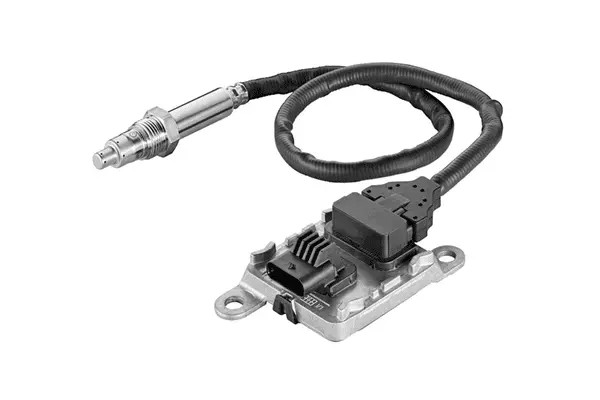 NOx Sensor in vehicle emission control system
NOx Sensor in vehicle emission control system
Using high-quality NOx sensors ensures that your vehicle complies with environmental regulations and reduces its impact on air quality. CARDIAGTECH.NET offers a range of NOx sensors to help you maintain a cleaner and more efficient vehicle. Contact us at CARDIAGTECH.NET for more information and expert advice.
4. What are the Symptoms of a Faulty Car Sensor?
Recognizing the symptoms of a faulty car sensor is crucial for maintaining your vehicle’s performance and safety. Here are some common indicators:
- Check Engine Light: This is often the first sign of a sensor issue.
- Poor Fuel Economy: Faulty sensors can disrupt the air-fuel mixture, leading to decreased fuel efficiency.
- Rough Idling or Stalling: A malfunctioning sensor can cause the engine to run poorly, resulting in rough idling or stalling.
- Increased Emissions: Faulty sensors can lead to higher emissions, which can cause your vehicle to fail an emissions test.
- Reduced Engine Power: A bad sensor can limit engine performance, resulting in decreased power and acceleration.
- Erratic Shifting: In automatic transmissions, faulty sensors can cause erratic or harsh shifting.
If you notice any of these symptoms, it’s essential to have your vehicle inspected by a professional to diagnose and repair the issue. CARDIAGTECH.NET offers diagnostic tools to help you identify sensor problems quickly and accurately.
5. How to Troubleshoot Car Sensors?
Troubleshooting car sensors involves a systematic approach to identify and resolve issues. Here are the general steps:
- Use an OBD-II Scanner: Connect an OBD-II scanner to your vehicle’s diagnostic port to read error codes.
- Research the Error Codes: Look up the error codes to understand what sensors might be malfunctioning.
- Inspect the Sensors: Visually inspect the sensors and their wiring for any signs of damage or corrosion.
- Test the Sensors: Use a multimeter to test the sensor’s voltage, resistance, and continuity according to the manufacturer’s specifications.
- Replace Faulty Sensors: If a sensor fails the test, replace it with a new one.
- Clear the Error Codes: After replacing the sensor, clear the error codes using the OBD-II scanner.
- Test Drive: Take the vehicle for a test drive to ensure the issue is resolved.
For accurate sensor readings and reliable performance, trust CARDIAGTECH.NET. Our tools are designed to help you keep your vehicle running smoothly.
6. How Can I Maintain Car Sensors for Longevity?
Maintaining your car’s sensors is essential for ensuring optimal performance and longevity. Here are some tips:
- Regular Inspections: Periodically inspect sensors and their wiring for any signs of damage or corrosion.
- Keep Sensors Clean: Clean sensors regularly to remove dirt, debris, and contaminants that can affect their performance.
- Use Quality Parts: When replacing sensors, use high-quality parts from reputable manufacturers to ensure reliability and accuracy.
- Follow Maintenance Schedule: Adhere to the manufacturer’s recommended maintenance schedule for sensor replacement and servicing.
- Address Issues Promptly: If you notice any symptoms of a faulty sensor, address the issue promptly to prevent further damage.
Regular maintenance and timely repairs can significantly extend the life of your car’s sensors and prevent costly repairs down the road.
7. How Do Environmental Sensors Contribute to Eco-Friendly Driving?
Environmental sensors, such as particulate matter and EGR sensors, play a crucial role in regulating emissions and promoting eco-friendly driving. According to the Environmental Protection Agency (EPA), these sensors help ensure compliance with legal requirements and reduce the vehicle’s environmental impact. By monitoring and controlling emissions, these sensors contribute to cleaner air and a healthier environment.
8. What Role Do Driver Assistance Sensors Play in Vehicle Safety?
Driver assistance sensors, including cameras, radars, and ultrasonic sensors, enable advanced driver assistance systems (ADAS) such as adaptive cruise control and lane departure warning. A report by the National Highway Traffic Safety Administration (NHTSA) highlights that ADAS technologies can significantly reduce the risk of accidents. These sensors facilitate functions like autonomous driving and collision prevention, enhancing driver awareness and safety.
9. How Do Comfort and Convenience Sensors Improve the Driving Experience?
Comfort and convenience sensors, including rain, ambient light, and proximity sensors, enhance driver comfort and convenience by automatically adjusting features like interior lighting, parking aids, and windshield wipers depending on external circumstances. A study by the Society of Automotive Engineers (SAE) indicates that these sensors can improve driver satisfaction and reduce workload. By automating various functions, these sensors make driving more enjoyable and less stressful.
10. What Happens If I Ignore a Faulty Car Sensor?
Ignoring a faulty car sensor can lead to several adverse outcomes, impacting your vehicle’s performance, safety, and longevity. Here are some potential consequences:
- Decreased Fuel Efficiency: A faulty oxygen sensor, for example, can cause the engine to burn more fuel, leading to decreased fuel efficiency and higher fuel costs.
- Increased Emissions: Malfunctioning sensors can result in higher emissions, potentially causing your vehicle to fail an emissions test and contribute to air pollution.
- Engine Damage: Ignoring a knock sensor can lead to engine knocking, which can cause severe damage to the engine’s internal components.
- Safety Risks: Faulty airbag sensors can compromise the effectiveness of the airbag system, increasing the risk of injury in the event of a collision.
- Costly Repairs: Delaying sensor repairs can lead to more significant and costly issues down the road, such as engine failure or component damage.
Addressing sensor issues promptly is crucial for preventing these adverse outcomes and maintaining your vehicle’s overall health and safety.
FAQ: Common Questions About Car Sensors
1. What is the most common car sensor failure?
The oxygen sensor is one of the most frequently failing sensors due to its constant exposure to exhaust gases and high temperatures.
2. How often should car sensors be replaced?
Sensor replacement intervals vary. Oxygen sensors typically need replacement every 60,000 to 100,000 miles, while others may last longer.
3. Can a bad sensor cause the car not to start?
Yes, a faulty crankshaft position sensor or mass airflow sensor can prevent the engine from starting.
4. Are aftermarket sensors as reliable as OEM sensors?
OEM sensors are generally more reliable due to their higher quality and precise calibration.
5. How can I test a car sensor at home?
Using a multimeter to check voltage, resistance, and continuity is a common method for testing sensors.
6. What tools do I need to replace a car sensor?
Common tools include a socket set, wrench set, screwdrivers, and an OBD-II scanner to clear error codes.
7. Can a car run without a specific sensor?
While some sensors are critical for operation, others may allow the car to run in a limited “limp” mode.
8. How do I know if a sensor is causing a check engine light?
Use an OBD-II scanner to read the error codes and identify the specific sensor causing the issue.
9. What is the role of a camshaft position sensor?
The camshaft position sensor monitors the position of the camshaft, which is essential for proper ignition and fuel injection timing.
10. How much does it cost to replace a car sensor?
Replacement costs vary depending on the sensor type, vehicle model, and labor rates, typically ranging from $100 to $500.
CARDIAGTECH.NET: Your Partner in Automotive Excellence
At CARDIAGTECH.NET, we understand the challenges faced by auto technicians and garage owners. Our mission is to provide you with the tools and equipment you need to enhance your work efficiency, reduce repair times, and increase accuracy. We offer a wide range of high-quality diagnostic tools, sensors, and maintenance equipment designed to meet the demands of modern automotive technology.
Facing Challenges? We Have Solutions!
- Physical Demands: Our ergonomic tools and equipment are designed to reduce physical strain and improve comfort during long hours of work.
- Constant Learning: Stay ahead of the curve with our advanced diagnostic tools and comprehensive training resources, ensuring you’re always up-to-date with the latest automotive technologies.
- Time Constraints: Our efficient and accurate tools help you diagnose and repair vehicles quickly, reducing turnaround times and increasing customer satisfaction.
- Competition: Stand out from the competition with our high-quality tools and equipment, enhancing your reputation and attracting more customers.
- Finding Quality Tools: CARDIAGTECH.NET offers a curated selection of top-quality tools from trusted manufacturers, ensuring durability and reliability.
Our Promise
CARDIAGTECH.NET is committed to providing exceptional service and support. Our expert team is always ready to assist you with your needs, ensuring you have the tools and knowledge to succeed.
Ready to Elevate Your Automotive Service?
Don’t let outdated tools hold you back. Contact CARDIAGTECH.NET today and discover how our solutions can transform your garage. Call us on Whatsapp at +1 (641) 206-8880 or visit our website at CARDIAGTECH.NET for more information.
Address: 276 Reock St, City of Orange, NJ 07050, United States
Take the first step towards a more efficient and profitable future with CARDIAGTECH.NET. Let us help you achieve excellence in automotive service!



